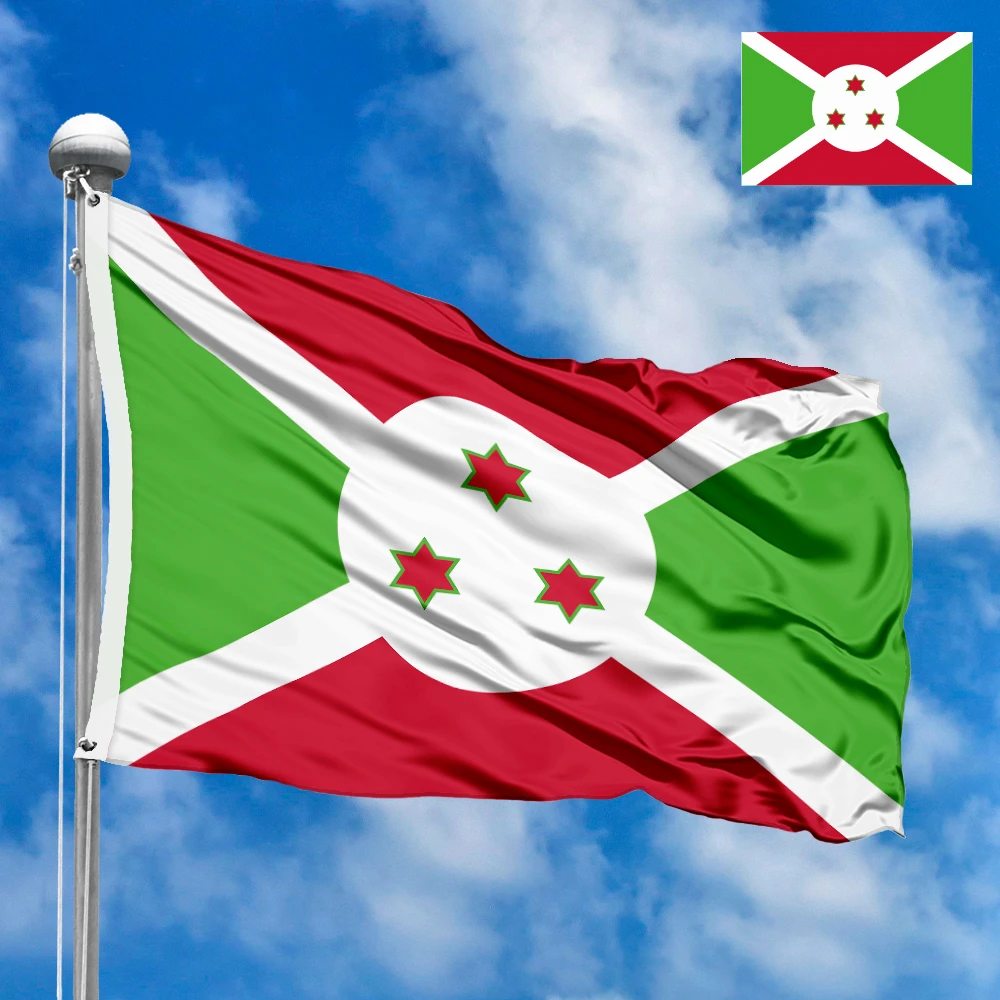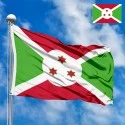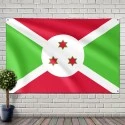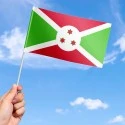Flag of Burundi
- Flag Type: State
- Proportions (official): 3:5
- Official name: Republic of Burundi
- Local name: Republika y'u Burundi, République du Burundi
- Sovereignty (year): YES (1962)
- Member of Organizations: UN, African Union, East African Community
- Country code, territory: BI, BDI, 108
- Capital: Gitega (political), Bujumbura (economic)
- Large cities: Bujumbura, Muyinga, Ngozi
- Population: ~13,700,000 (2024, UN)
- Religions: Christianity ~90%, Traditional beliefs ~5%
- Area (km²): 27 834
- Highest point: Mount Heha (2,684 m)
- Lowest point: Lake Tanganyika (772 m)
- Currency: Burundian franc (BIF, FBu)
- Languages: Kirundi, French, English
- Dialing code: +257
- National domain: .bi
Flag Information
General information
Demography and Culture
Economy and communications
- All Flags
- Flags of Countries by Continent
-
Flags of Organizations
- Flags of UN countries
- Flags of the European Union countries
- Flags of NATO countries
- Flags of the countries of the Organization of Islamic Cooperation
- Flags of the countries of the Organization of American States
- Flags of the Arab League countries
- Flags of the African Union countries
- Flags of the countries of the Union of South American Nations
- Flags of the Commonwealth of Nations
- Flags of the countries of the Secretariat of the Pacific Community
- Flags of the Nordic Council countries
- Flags of the Caribbean Community
- Flags of the countries of the Association of Southeast Asian Nations
- Flags of the East African Community
- Flags of the countries of the Organization of Turkic States
- LGBT Community Flags
- Historical Flags
- Ethnic Flags
- Flags of the USA (states)
Description
The national flag of Burundi is a striking and deeply symbolic emblem, a vibrant testament to the nation's independence, its historical struggles, and its aspirations for unity, peace, and progress. Adopted on June 28, 1967, nearly five years after gaining full independence from Belgium on July 1, 1962, it replaced the country's monarchical flag, signifying a shift towards a republican identity. This flag is not just a piece of cloth; it is a profound visual narrative that encapsulates the essence of Burundi and its people.
Design and Symbolism: A Crux of Unity and Hope
The flag of Burundi features a distinctive design centered around a white saltire (a diagonal cross) that divides the flag into four fields. These fields, along with the central emblem, are imbued with rich symbolism:
-
The White Saltire: Peace and Purity of the Nation's Intentions. The most prominent feature of the flag is the broad white diagonal cross that extends from corner to corner. White, universally, is a color of peace, purity, and innocence. In the context of Burundi, this white saltire powerfully symbolizes the nation's unwavering commitment to peace – both internally among its diverse communities and externally with its neighbors and the wider world. It represents the purity of the nation's intentions as it strives for reconciliation and harmony after periods of conflict. Furthermore, the cross shape itself can be interpreted as a unifying element, bringing together the different parts of the nation under a common aspiration for tranquility and stability. It is a constant reminder of the desired state of national concord and the pure motives behind its governance.
-
The Red Quadrants: The Sacrifices for Freedom and National Unity. The two horizontal fields (top and bottom) created by the white saltire are colored red. Red is a potent color, often associated with courage, valor, and the blood shed in defense of one's homeland. For Burundi, the red quadrants honor the sacrifices made by the nation's heroes and martyrs who fought for independence and sovereignty. It represents the blood shed in the struggle against colonialism and in the various conflicts that have marked Burundi's history. Beyond sacrifice, red also signifies the passion and zeal of the Burundian people for their nation and their unwavering determination to defend its unity and integrity. It is a testament to the resilience and fortitude of a people who have endured much but remain committed to their national identity.
-
The Green Quadrants: Hope, Prosperity, and the Nation's Natural Resources. The two vertical fields (hoist and fly) created by the white saltire are colored green. Green is a widely recognized symbol of hope, prosperity, and the richness of the natural world. In Burundi's context, the green quadrants represent the nation's aspirations for a prosperous future, driven by its fertile land and abundant natural resources. Burundi is an agricultural country, and green thus embodies its agricultural wealth, lush landscapes, and potential for growth and development. It symbolizes the hope that the nation places in its land to provide sustenance and a better quality of life for its citizens. It also subtly alludes to the potential for environmental stewardship and sustainable development, recognizing the importance of natural resources for long-term national well-being.
-
The Central Emblem: Three Stars of National Pillars. At the very center of the flag, superimposed on the white saltire, is a white disk containing three red, six-pointed stars. This central emblem is a condensed representation of the fundamental pillars of the Burundian nation. The three stars are universally understood to symbolize:
-
Unity (Ubumwe): The aspiration for all Burundians to live together in harmony, transcending ethnic and regional differences.
-
Work (Ibikorwa): The commitment of the people to hard work and dedication as the foundation for national development and progress.
-
Progress (Iterambere): The collective ambition of the nation to move forward, to achieve economic, social, and cultural advancement, and to build a better future for all its citizens. The six points on each star are sometimes interpreted as representing the six provinces (or some historical administrative divisions) or the six major ethnic groups, but the official interpretation focuses on the triad of Unity, Work, and Progress. The red color of the stars reinforces the idea that these pillars are built upon the sacrifices and courage symbolized by the red quadrants.
-
Together, the design elements of the Burundian flag form a powerful and cohesive message: a nation built on peace (white), honoring the sacrifices for its freedom (red), aspiring to a prosperous future through its natural wealth (green), and guided by the foundational principles of Unity, Work, and Progress (stars). It is a visual pledge to its past, present, and future.
Dimensions and Proportions: A Balanced Canvas of National Identity
The official dimensions and proportions of the Flag of Burundi are precisely defined to ensure its consistent and recognizable appearance across all contexts. The flag adheres to a width-to-length ratio of 3:5. This specific ratio is common among national flags, providing a balanced and aesthetically pleasing rectangular shape that is easily adapted for various display purposes, from large ceremonial flags to smaller hand-held versions.
The central design, featuring the white saltire, is meticulously proportioned to ensure visual harmony. The width of the white saltire itself is significant, making it a prominent feature that draws the eye and emphasizes the concept of peace. The four triangular fields created by the saltire (two red, two green) are perfectly symmetrical, symbolizing the equal importance of the sacrifices (red) and hopes for prosperity (green) that define the nation.
The central white disk containing the three red stars is also precisely placed and sized to be the focal point without overwhelming the overall design. Its diameter is carefully calculated to ensure visibility and balance within the intersection of the saltire. The three stars within the disk are arranged in a specific triangular pattern, further reinforcing their symbolic significance of unity, work, and progress. Their six points are distinct and evenly spaced, adding to the flag's unique character.
This precise proportional division ensures that the flag is consistently reproduced correctly, maintaining its intended visual impact and symbolic integrity. Whether displayed at official government buildings, international diplomatic events, sporting competitions, or national celebrations, the 3:5 ratio, the prominent white saltire, and the perfectly centered emblem ensure that the flag of Burundi always projects a strong, unified, and balanced image, clearly conveying its national message to both its citizens and the world. The meticulous adherence to these dimensions is crucial for upholding the flag's dignity and ensuring its accurate representation as a proud national emblem.
History and Evolution: From Monarchy to Republic
The history of Burundi's national flag is relatively short but marked by a significant transition from a colonial protectorate under monarchy to an independent republic. The current flag, adopted in 1967, replaced an earlier version that reflected the country's monarchical past.
-
Colonial Era (Pre-1962): German and Belgian Influence. Prior to gaining independence, Burundi was part of German East Africa. During this period, the German flag would have been flown. After World War I, it became a Belgian-mandated territory (part of Ruanda-Urundi), and thus the Belgian flag (black, yellow, and red vertical stripes) would have been the official ensign. No distinct Burundian flag representing the indigenous population existed during this time.
-
Kingdom of Burundi (1962-1966): The Mwami's Standard. On July 1, 1962, Burundi gained independence as a constitutional monarchy, the Kingdom of Burundi, under Mwami (King) Mwambutsa IV. The flag adopted upon independence reflected this monarchical system. It was a horizontal tricolor of green, white, and red. The most distinguishing feature was a drum (karyenda), a traditional royal symbol, placed in the center of the white stripe, sometimes flanked by a sorghum plant. The drum was an ancient symbol of the mwami's power and the continuity of the kingdom. This flag symbolized the newly independent nation while honoring its centuries-old monarchical heritage.
-
The Republican Transition (1966-1967): A Shift in National Identity. In November 1966, a coup d'état led by Captain Michel Micombero overthrew the monarchy, establishing the First Republic of Burundi. With this profound political shift came the need for a new national symbol that would reflect the republican ideals and a break from the monarchical past. The current national flag was officially adopted on June 28, 1967. The design retained the white saltire and the red and green colors from the previous flag's underlying color scheme, but it significantly removed the royal drum (karyenda). In its place, the three red, six-pointed stars were introduced, symbolizing "Unity, Work, Progress" – the new guiding principles of the republic. This change marked a deliberate and clear separation from the royalist past and underscored the new republican values.
-
Post-1967 Stability: An Enduring Emblem. Since its adoption in 1967, the flag of Burundi has remained unchanged. This remarkable continuity, despite various political upheavals and conflicts that have affected the nation, speaks to the enduring acceptance and timeless relevance of its symbolism. The flag has served as a consistent and beloved emblem for the Burundian people, symbolizing their resilience, their national unity, and their unwavering hope for a better future, transcending different political regimes. It stands as a constant reminder of the principles upon which the republic was founded and the collective aspirations of its citizens.
In essence, the evolution of Burundi's flag reflects its journey from a colonial entity to a sovereign monarchy, and then to a republic, with each change signifying a deliberate redefinition of its national identity and aspirations. The current flag stands as a powerful symbol of its republican values and its commitment to peace, unity, work, and progress.
Regional Context and East African Identity: A Unique Design in a Complex Landscape
The flag of Burundi holds a unique position within the vexillological landscape of East Africa and the Great Lakes region. While it shares a common post-colonial history with its neighbors, its design choices set it apart from many other flags in the area, particularly those of its immediate neighbors.
-
Shared Colonial Past, Divergent Flag Designs: Burundi, like its neighbor Rwanda, was part of the Belgian mandate of Ruanda-Urundi. Both nations gained independence on similar trajectories. However, while Rwanda adopted a flag that initially used Pan-African colors with an "R" (and later a new design), Burundi's flag, even in its monarchical phase, deviated significantly from the typical Pan-African green-yellow-red tricolors prevalent in many newly independent African states. The prominent white saltire is a rare design element among African national flags, making Burundi's flag immediately recognizable and distinct. This sets it apart from the more common horizontal or vertical stripe patterns found across the continent.
-
Emphasis on Internal Unity and Peace: The strong emphasis on peace (white saltire) and unity (one of the three stars) on the Burundian flag reflects the nation's historical challenges with internal divisions and conflicts. This symbolism contrasts with flags that might primarily emphasize liberation struggles (through red) or natural resources (through green), though those elements are present. For Burundi, the explicit visual commitment to peace and unity is a critical message, given its past. This resonates deeply within the Great Lakes region, which has experienced its share of internal strife.
-
Less Emphasis on Pan-African Colors: While the flag contains red (sacrifice) and green (hope/prosperity), it notably lacks the golden/yellow color often associated with Pan-Africanism, except for a subtle yellow border around the central disk in some older depictions, which is not an official part of the current design's primary colors. The primary colors are red, green, and white. This further distinguishes it from many flags that directly incorporate all three Pan-African colors. This choice might reflect a more inward-looking focus on national specificities rather than a broader ideological alignment with pan-African movements through color symbolism.
-
Symbolic Abstraction vs. Concrete Representations: Unlike some flags that feature concrete national symbols (e.g., animals, tools, or geographical features), the Burundian flag relies on abstract symbols (saltire, stars) to convey its message. The stars, representing unity, work, and progress, are philosophical ideals rather than tangible objects, adding a layer of sophisticated abstraction to the national emblem.
-
Shared Post-Colonial Aspirations: Despite its unique design, the flag of Burundi is still a product of the shared post-colonial experience in Africa. Its adoption in the mid-1960s mirrors the wave of self-determination that swept across the continent. It signifies a collective regional moment of newly asserted sovereignty, a deliberate move away from colonial ensigns, and the establishment of distinct national symbols rooted in national aspirations. This shared historical context of breaking free from colonial rule creates an unspoken bond with its neighbors.
In essence, the flag of Burundi is a powerful visual statement of its unique national identity and its specific historical trajectory within East Africa. Its distinctive design emphasizes its foundational values of peace, unity, work, and progress, making it a recognizable and meaningful symbol in a region characterized by diverse national expressions. It stands as a testament to Burundi's resilience and its ongoing pursuit of stability and development.
Interesting Facts About The Flag of Burundi:
-
Designed After Independence: While Burundi gained independence in 1962, the current flag was adopted in 1967, replacing an earlier monarchical flag. This makes it a post-independence design explicitly for the new republican era.
-
Unique Saltire Design in Africa: The prominent white diagonal cross (saltire) is a very rare design element among African national flags, making Burundi's flag visually distinct and easily identifiable on the continent.
-
Symbolism of Three Stars: The three red stars in the center officially represent the national motto: "Unity, Work, Progress" (Ubumwe, Ibikorwa, Iterambere). This direct connection to the national motto is a strong feature.
-
Six Points on Stars: Each of the three stars has six points. While the official meaning is tied to the motto, some interpretations suggest the six points could also refer to the six provinces (though the administrative divisions have changed over time) or the six major ethnic groups historically present.
-
Replaced a Royal Flag: The current republican flag replaced a monarchical flag that featured a royal drum (karyenda), a symbol of the former Mwami (King). This change clearly marked the transition from a kingdom to a republic.
-
Colors Represent Aspirations: The colors are highly symbolic: White for peace, Red for the sacrifices made for independence, and Green for hope and the nation's natural resources.
-
Unchanged Since 1967: Despite periods of significant political turmoil and conflict, the flag's design has remained unchanged since its adoption in 1967. This demonstrates its enduring acceptance as a unifying national symbol.
-
Not Directly Pan-African Colors: While red and green are present, the absence of a distinct yellow/gold stripe (often a core Pan-African color) as a primary background element, combined with the dominant white saltire, makes its color scheme subtly different from many other Pan-African influenced flags.
-
Ratio 3:5: The flag's official proportions are 3:5, a common ratio for national flags, giving it a balanced rectangular shape.
-
Focus on Internal Harmony: The strong emphasis on peace and unity through the white color and the "Unity" star reflects the Burundian nation's deep-seated desire for internal cohesion and reconciliation after periods of strife.
-
Often Displayed Vertically: Like many flags, it is often displayed vertically, where the hoist is at the top. The design, with its central emblem, remains clear regardless of orientation.
Significance for the Inhabitants: A Banner of Identity, Resilience, and Shared Future
For the people of Burundi, their national flag is much more than just a piece of fabric; it is a profound and deeply cherished emblem that encapsulates their national identity, their collective memory of struggle, and their unwavering aspirations for a peaceful and prosperous future. It serves as a constant visual reminder of their hard-won sovereignty and the distinct values that define them as Burundian.
The white saltire at the heart of the flag resonates deeply with the Burundian people as a symbol of their unyielding commitment to peace and purity of intent. After enduring periods of profound conflict and division, the white cross serves as a powerful reminder of the national yearning for reconciliation and harmony. For every Burundian, it embodies the ideal of a nation united in peace, a beacon of hope that transcends past grievances. It reflects a collective prayer and a determined effort towards building a society free from strife, where purity of purpose guides national endeavors.
The red quadrants are a solemn tribute to the sacrifices made for the nation's freedom and sovereignty. The color red, symbolizing the blood shed by heroes and martyrs, evokes a strong sense of reverence and national pride. For the inhabitants, these red sections are a powerful reminder of the high cost of independence and the resilience of a people who fought for their self-determination. It is a symbol that unites them in honoring their history, acknowledging the suffering, and reaffirming their collective commitment to protecting the nation's hard-won autonomy. It instills a sense of shared responsibility born from shared sacrifice.
The green quadrants represent the hope for a prosperous future and the profound connection to Burundi's fertile land and abundant natural resources. For a predominantly agricultural society, the green color is deeply significant, symbolizing the potential for growth, sustenance, and improved livelihoods. It embodies the aspirations for economic development, food security, and environmental sustainability. For Burundians, this green is a vivid reminder of their rich natural heritage and the promise it holds for a better quality of life for current and future generations. It fosters a sense of optimism and a belief in the nation's capacity to thrive.
The three red stars in the central white disk are perhaps the most potent symbols, representing the national motto: "Unity, Work, Progress" (Ubumwe, Ibikorwa, Iterambere). These ideals are foundational to the Burundian identity.
-
Unity speaks to the profound yearning for cohesion among all ethnic groups and regions, a crucial aspiration given the country's past.
-
Work emphasizes the value of diligence and effort as the engine of national development and individual well-being.
-
Progress encapsulates the collective ambition to move forward, to achieve social, economic, and cultural advancement, and to build a better future for every citizen. For the inhabitants, these stars are a constant call to action, inspiring them to work together, to contribute to their nation's development, and to strive for collective advancement. They represent the guiding principles for individual and national conduct.
When the flag is proudly displayed—at national events, in schools, on government buildings, during sporting competitions, or in private homes—it invariably ignites a profound sense of patriotism, unity, and shared identity among the Burundian people. It serves as a powerful reminder that despite challenges, they are united by a common history, shared aspirations, and a collective commitment to building a peaceful, prosperous, and progressive nation. It is a cherished emblem that evokes deep pride and a collective determination to uphold the values it represents for generations to come.
In the demonstration images, full-size flags are shown with proportions of 2:3, and hand-held flags with proportions of 1:2.
Donation
Download
Completely free for commercial and non-commercial use (public domain).
You can freely use them in your news magazines, websites, software, mobile applications.
We appreciate a backlink to https://flagssite.com
Raster files - Flag of Burundi (PNG, JPG)
 Waving flag
Waving flag
- PNG format (transparent background), 72dpi, dimensions in Pixels (px), aspect ratio 3:4.
- 15х20 px
- 30х40 px
- 60х80 px
- 120x160 px
- 240x320 px
 Sizes:
Sizes:
"v15" - image size (by height); if necessary, replace with available: v15, v30, v60, v120, v240.
!!! For resizing, use the Latin (eng) keyboard layout.
<img src="https://flagssite.com/flags/v15/20406.png" alt="Flag of Burundi">
 Round flag
Round flag
- PNG format (transparent background), 72dpi, dimensions in Pixels (px), aspect ratio 1:1.
"d15" - image size (diameter); if necessary, replace with available: d15, d30, d60, d120, d240.
!!! For resizing, use the Latin (eng) keyboard layout.
<img src="https://flagssite.com/flags/d15/20406.png" alt="Flag of Burundi">
 Rectangular flag 2:3
Rectangular flag 2:3
- JPG format, 72dpi, dimensions in Pixels (px), aspect ratio 2:3.
"h30" - image size (by height); if necessary, replace with available: h15, h30, h60, h120, h240, h360, h480.
!!! For resizing, use the Latin (eng) keyboard layout.
<img src="https://flagssite.com/flags/h30/20406.jpg" alt="Flag of Burundi">






 Sizes:
Sizes:
 Sizes:
Sizes: